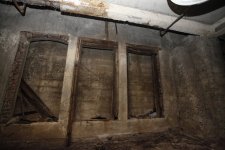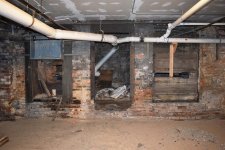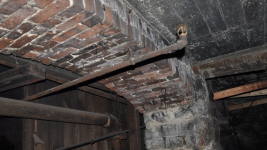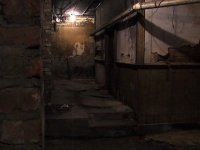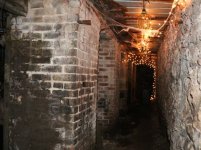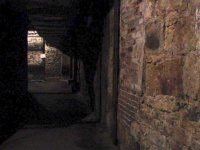We clearly have multiple theories which provide possible explanations of why lower floors of the 19th, and early 20th century buildings ended up buried under up to 20 feet of mud. Whether it was a single catastrophic event, or a combination of several different ones remains to be seen. In reality, we do not even know if it was an artificially created, or a 100% natural catastrophe. Yet, we do understand that there is this, for the most part, officially explained phenomena of "buried first floors", and "underground cities". The academic narrative suggests we move along, for there is nothing special to see there. We, obviously, think otherwise.
Combined effort of multiple independent researchers slowly inches us towards a possible solution to the riddle. Most importantly, with every uploaded video, or published article, the exposure, as well as public awareness, goes up.
Today I wanted to attract your attention to a new video uploaded by CONSPIRACY-R-US. It is titled "Buried Street Levels and the Mud Flood". In the video he talks about two cities displaying evidence of what we universally call "The Mud Flood".
KD: It appears there are way more of these underground cities than we realize. Some of them became a money making machine by providing underground tours. In my home state of Washington we have at least two:
If your city or town was established some time in the 19th century, look for tell tale signs of the Mud Flood. Port Townsend, WA could serve as a good example of what to look for.
Please watch the above video, and share your opinion with the blog members.
Combined effort of multiple independent researchers slowly inches us towards a possible solution to the riddle. Most importantly, with every uploaded video, or published article, the exposure, as well as public awareness, goes up.
Today I wanted to attract your attention to a new video uploaded by CONSPIRACY-R-US. It is titled "Buried Street Levels and the Mud Flood". In the video he talks about two cities displaying evidence of what we universally call "The Mud Flood".
Chattanooga, TN
Underground Chattanooga is a below-ground area of Chattanooga, Tennessee that resulted from citizen efforts to prevent floods in the aftermath of the flood of 1867. It was rediscovered by Jeff Brown in the 1970s.- Archaeologist and University of Tennessee-Chattanooga professor Jeff Brown started noticing small clues to the underground world while walking around downtown Chattanooga. He learned from utility workers of doorways leading to nowhere and underground tunnels and rooms. Entire basements of buildings were once first floors, including some obvious storefronts complete with windows. None were marked on maps and no one could tell him why these features were there. He discovered that much of the city had been backfilled, by six feet at 9th Street and up to 20 feet at other places, but very little documentation of this process existed.
- Because of lack of historical documentation backing up the raising of the city's streets, some suggest that it is just a legend. Some suggest that it was a common practice for the basements in buildings downtown to have stairs leading down from the street. These walk-downs, some complete with handrails leading down towards a basement entrance, existed in downtown Chattanooga at the time. The basements had windows to provide light as well as ventilation. There has been some photo documentation of structures over a span of thirty years that show little or no change. An explanation for the archways in some buildings could be explained by being used as support for the building. Some suggest that the only evidence is that of a normal growing city infrastructure and, no monumental effort to raise the city's streets. After 1925, the use of commercial basements began to fade. Over time parts of the city began to be filled in that fell below grade.
- During the nineteenth and early twentieth centuries, Chattanooga experienced bouts of systematic flooding roughly every decade. The impact of flooding was severe; it affected many of Chattanooga's manufacturers as well as the merchants in the area. Building damage was frequent as well as the interruption of daily life. Chattanooga's commerce was constantly affected by the flooding, After years of suffering through flooding, in March 1867 Chattanooga experienced a record flood following four days of heavy rainfall. The river had risen 53 feet (16 m), which was 15.5 feet higher than a flood twenty years earlier. The rain lasted for four days, bringing the water level in the Tennessee River 28 feet above flood range. The bridge across the river was destroyed, as were many buildings. There was a considerable loss of life and looting took place. Upwards of 4,000 homeless in Chattanooga were ferried out of the flooding city to areas of higher ground.[ During a 64-year span ranging from 1875 to 1938, the Tennessee River had risen above its flood range more than 70 times.
Leavenworth, KS
The underground city in Leavenworth, Kansas remains a big puzzle. Noone knows who built it and for what reason.- Underneath the sidewalk of downtown Leavenworth sits a 200-year-old system of tunnels, a component of the town that few know, but is now becoming more open to the public.
- Very little is known about this mysterious underground city. All we have are speculations. Researcher who examined the place discovered windows, doors and narrow paths beneath a title company at South Fourth and Delaware streets that lead to storefronts stretching several city blocks and perhaps beyond.
- A lot of people refer to this as the Leavenworth underground. Few seem to know the real origins of this city. Some speculate that businesses just added stories over time as paved roads and new construction standards evolved. Others point to the Underground Railroad.
- The underground city of Leavenworth is by no means ancient, but it is nevertheless an important piece of history that should not be neglected and forgotten about. Hopefully more research will be conducted to shed more light on this enigmatic and little known place.
KD: It appears there are way more of these underground cities than we realize. Some of them became a money making machine by providing underground tours. In my home state of Washington we have at least two:
If your city or town was established some time in the 19th century, look for tell tale signs of the Mud Flood. Port Townsend, WA could serve as a good example of what to look for.
Please watch the above video, and share your opinion with the blog members.


